Editor’s Note:
Most of what we found among Pitt Rivers’ online collections ended up either being unclear as to whether it was actually technically from Ngukurr– as can be the case with unclear labelling and categorizing of items– or from the work and legacy of figures like Walter Baldwin Spencer, James George Frazer, Elsie Masson, and Henry Balfour.
We want to be honest: in many ways, it’s disappointing that our research ended up circling around the work and direct narratives of these white scholars and anthropologists who spent time in the region with various tribes as opposed to Aboriginal people in Ngukurr asserting their own stories, cultural beliefs, memories, wisdom and livelihoods. We think it speaks to the nature of institutions like Pitt Rivers’ that we were unable to find documents from Ngukurr Aboriginal Australians or even Northern Territory Aboriginal people, and moreover, it certainly speaks to a legacy of how deeply embedded colonialism is in these institutions and beyond.
We don’t want to romanticize or uplift the at-times exotifying lens that layers over the way that Baldwin Spencer talked about totemic systems, or the way that Masson depicts and frames the people she photographed. We wish we knew more of the names of the people Masson photographed; we wish that Spencer had said specifically what tribes he spent time with.
We want to say upfront that Aboriginal people from Ngukurr (elders and youth alike) are still living, reviving their traditions and languages and that this kind of colonial legacy will always be very complicated and tough to sift through. That doesn’t mean that Aboriginal Ngukurr residents and communities don’t deserve our full attention, respect and more; in fact, it means the opposite.
For those of you who are interested, we recommend starting here:
Ngukurr News – Home | Facebook
Welkam la Ngukurr – Welcome to Ngukurr on Vimeo
Welcome to the Ngukurr Language Centre (ngukurrlc.org.au)
Objects
While searching the Pitt Rivers Museum Database of Object Collections, we were able to surface 13 objects by searching “Roper River” in the Geographical Region search bar. At first, we found searching difficult because none of the objects we were discovering were explicitly labeled as objects from Ngukurr; these 13 objects are the closest to Ngukurr that we could find. They include weapons, tools, and ornaments, and their donation dates range from 1900 to 1997. Nearly half of the objects were donated to the museum by Robert Francis Wilkins in 1900, though little information was available about Wilkins himself. Below, a few of the items from the Pitt Rivers collection are spotlighted.
a red and white swan-necked boomerang
a brow-band made from painted stringwork
a double-bladed saw
Photography
While searching the Pitt Rivers Museum Database of Photography Collection, we were able to surface 28 images using the search terms “Elsie Masson, Northern Territory, Roper River/Bar.” Nine images are highlighted below.
Elsie Masson was born in 1890 in Melbourne, Australia. Elsie’s father was a good friend and colleague of Walter Baldwin Spencer, an anthropologist at Melbourne University. In 1911, the Commonwealth Government assumed control of the Northern Territory, and Spencer was appointed to lead a preliminary expedition. Impressed with the results, Spencer and some of his University colleagues, including John Gilruth, moved to the Northern Territory. In 1913, Elsie, just 23 years old, moved to the Northern Territory to become an au pair for the Gilruth household. While in the Northern Territory, Elsie photographed her experiences, and many of her photographs show the Roper River Mission, which is now Ngukurr. Elsie also wrote a report for Baldwin Spencer on the Roper River Mission titled An Untamed Territory. Elsie married Polish anthropologist, Bronislaw Malinowski, and never returned to the Northern Territory. Her photographs were donated to the Pitt Rivers Museum by daughter Helena Wayne.

Three Aboriginal men standing in line, holding long poles, in front of Roper River Police Station. (1998.306.89) 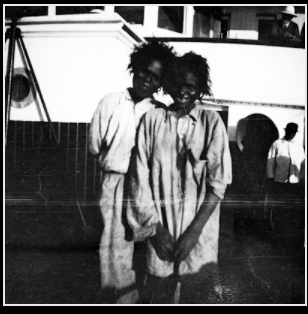
Two Aboriginal girls, possibly Judy and Norah, standing on deck of ship, possibly HMCS ‘Stuart’. (1998.306.93.1) 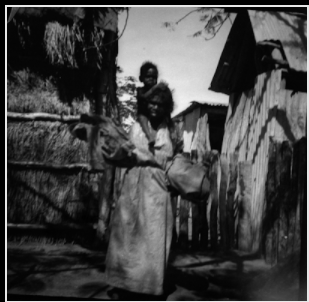
Aboriginal woman carrying young child on shoulders, with bundles in each hand, standing in front of buildings. This appears to be the same woman as in 1998.306.99. (1998.306.90) 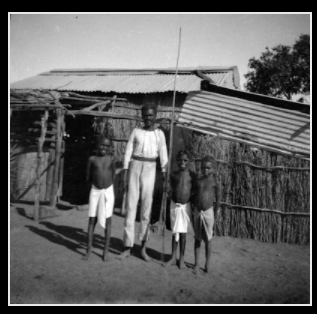
Aboriginal man and three young boys, standing in front of building. The man holds a long pole.(1998.306.81) 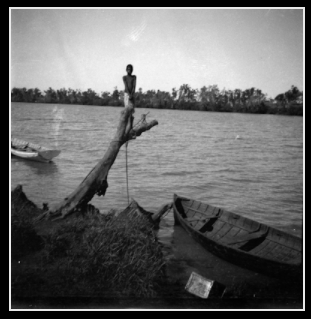
Landing place at the Mission Station, Roper River. Aboriginal boy standing on stump of tree with rowing boat moored to it, second boat moored further up river. (1998.306.77) 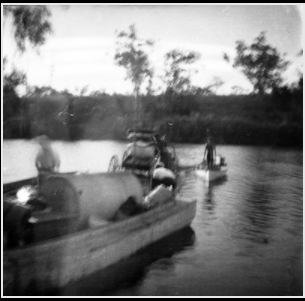
Rowing boat and two punts crossing river. One of the punts is loaded with a buggy. (1998.306.98) 
View of ship, probably HMCS ‘Stuart’, on river. (1998.306.93.1) 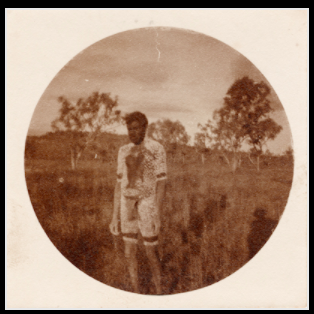
Full-length portrait of Aboriginal man, Bob, displaying body paint for corroboree. (1998.306.160) 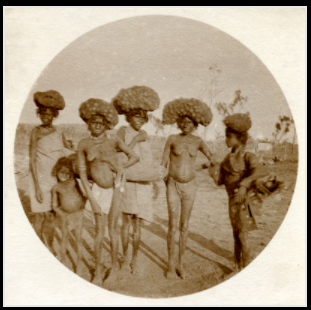
Group of five Aboriginal women and one girl carrying string bags of lily bulbs balanced on their heads. (1998.306.159)
Manuscripts
Sir Walter Baldwin Spencer was a British biologist and anthropologist known mostly for his ethnographic fieldwork with Aboriginal Australians. He was born in 1860 and attended Owens College for drawing 1879, and got a scholarship to study science at Oxford in 1881. He was asked to assist two of his professors, Moseley and Tylor, in moving the Pitts-River ethnographic collection to Oxford. He became the foundational chair of biology at the University of Melbourne in 1887. Along with his friend and colleague Sir David Masson, he created many laboratories and research facilities in this position, but most importantly, he went on several excursions into the field. During his fieldwork, he operated as a scientist, but he lived among several Aboriginal groups and wrote of his experiences. The letter below was written during one of these scientific expeditions.
Unfinished Transcript of Walter Baldwin Spencer letter to James George Frazer
University of Melbourne,
September 18th, 1911.
From Spencer (Melbourne) to Frazer. Apologies for long failure to write. The loss of Fison and Howitt. Gillen has also become ill and helpless. Spencer has made an expedition to the Northern Territory, under the auspices of the Commonwealth Government. His main findings. The connection of Intichiuma ceremonies with a precarious food supply. A curious totemic system among certain tribes along the Roper river. Beliefs about the sound of the bull-roarer. No trace of anything like belief in a Supreme Being. “The Commonwealth Government is about to undertake measures for the settlement of the Northern Territory, which means that the Aborigines will very rapidly become “civilised”. Plans for another trip to study a tribe in Melville Island. An interesting analogy between an Aboriginal belief and classical mythology, raised by Professor Tucker of Cambridge.
Description from Pitt Rivers’ Curators
Page 2:
“However this year the Commonwealth frequenting? Australia agreed to send a small party up the Northern Territory to make preliminary investigation, and I went as leader of this. It was delightful once more to be amongst the natives, although our time was very limited. I was able to secure some valuable information.
We went to Darwin and from there across to Melville Island. Then we returned to Darwin and travelled south about 200 miles + then across the continent to the fuel of Carpentaria.
The ? things I found were that amongst all the tribes, the idea of reincarnation is universal, and so also is the idea that sexual connection has nothing, if necessary, to do with procreation. The latter fact is interesting because it ? that this belief exists among the tribes extending from south to north across the centre of Australia. I did not find in any of these Northern tribes anything like Intichiuma? ceremonies nor could I find any restriction in regard to eating the Totemic animals or plants. ”
Middle of page 3:
“In one or two tribes along the Roper River I came across a very curious totemic system. A man must marry a woman with a particular totem, but the children belong to a different totem from what is either their father or mother. For example, a rain man must marry a ‘paddy melon’ (species of small kangaroo) woman and their children are Euro (a kangaroo) A porcupine man must marry a lizard woman and their children are bats. In their tribes, each ‘class’ has a certain totem assigned with it.
I must wish that I could have been able to study this system in greater detail than was permitted because it is quite different from anything that I have met with before. In these tribes, the natives were quite clear when the power that the spirit children harness the night ???? with where they never go.
In all of the tribes, I found that the woman + children believe that the sound of the bull-roarer in the voice and great spirit that comes to take away the boys when they are muriated? and also that the boys are told during the cucriata? ceremony when they are shown the churinga for the first time that the noise is not the voice of a spirit but is made by the churinga, the latter having been used by one of the mythic ancestors of the tribe. ”
End of page 4:
“I could find no trace of anything like a belief in a supreme being + with, of course, difference in detail, the beliefs of these northern tribes are clearly similar to that of the central tribe.”
Timeline of Events: Masson, Roper River, Campbell Trial, and more
1890: Elsie Masson is born in Melbourne, daughter of David Orme Masson and Lady Masson. Her father, David, was a friend to Sir Baldwin Spencer, both of whom were professors and chairs of their respective departments at Melbourne Uni.
1908: Roper River Mission established by the Church Missionary Society at what’s now known as Ngukurr.
January, 1911: Commonwealth Government takes control of Northern Territory, and appoints Spencer to lead a scientific expedition of the area, alongside John Gilruth. Spencer was then appointed to Darwin, the capital of the Northern Territory for a year as Chief Protector of Aboriginal peoples there.
September, 1911: From the University of Melbourne, Spencer writes a letter to a colleague, Frazer, about a short trip he took recently to Roper and describes what he learned of the totemic system, certain ceremonies, and items he observed from a few of the tribes there.
1912: Gilruth gets the position of Administrator of Northern Territory.
April, 1913: Masson becomes an au pair for Gilruth’s household and then leaves by the end of 1914.
1913: Masson was involved with the proceedings of the murder of Jim (James) Campbell, a white man, and the subsequent pinning of said murder on nine Aboriginal men. Masson’s photography of trepang boilers and her argument that the nine Aboriginal men most likely took revenge for Campbell having pushed an Aboriginal elder into a boiler helped to convince the jury and public that Campbell’s killing was more complicated than it initially seemed. The Aboriginal men got a life sentence of imprisonment with hard labor as opposed to execution.
1913 or ‘14: Masson writes a report for Spencer on Roper River Mission.
1919: Masson marries famous Polish anthropologist Bronislaw Malinowski.
1935: Masson dies at the age of 45.
March, 1998: Helena Wayne, Masson’s daughter, donates the set of photos of Roper and its residents shown above to Pitt Rivers’ collections.
*Important note about the timeline*
Sir Walter Baldwin Spencer was a co-creator of some of the photographs taken by Elsie Masson in Pitt Rivers’ photography collections. The set of photos taken by presumably Masson and Spencer are all dated from between 1911-1914, meaning that it’s possible that this trip depicted by Spencer in the letter could have been one of the ones in which Masson was also present and they took photos of residents of the Roper River Mission. It’s unclear how many times Spencer returned to Ngukurr in that span of time between 1911 and 1914, if at all, or if this short trip was all he did. Regardless, it’s certainly significant and interesting to think about in terms of timeline.
Sources For Further Reading
Chapter 5 (pp.77-96) “Popularizing Anthropology: Elsie Masson and Baldwin Spencer” in Photography, Humanitarianism, Empire (Jane Lydon 2016)
An Untamed Territory, Elsie Masson. available online: https://archive.org/details/untamedterritory00massuoft/page/n8/mode/2up
Helena Wayne (Masson and Malinowski’s daughter) published The Story of a Marriage: The Letters of Bronislaw Malinowski and Elsie Masson in 1995.
Masson wrote a report for Baldwin Spencer on the Roper River Mission, and this document is accessible online. See the 7-page document here: http://spencerandgillen.net/objects/50ce72f5023fd7358c8a952c “Impressions of the Roper River Church of England Mission to Aborigines’, 13 July 1913. Museum Victoria XM6167, ‘Spencer and Gillen: a Journey through Aboriginal Australia’ website: http://spencerandgillen.net/ accessed 20 May 2015.
Works Cited
- “Hidden Women Of History: Elsie Masson, Photographer, Writer, Intrepid Traveller”. 2018. The Conversation. https://theconversation.com/hidden-women-of-history-elsie-masson-photographer-writer-intrepid-traveller-107808.
- “Spencer & Gillen – A Journey Through Aboriginal Australia”. 2021. Spencerandgillen.Net. http://spencerandgillen.net/.
- “Biography – Sir Walter Baldwin Spencer – Australian Dictionary Of Biography”. 2021. Adb.Anu.Edu.Au. https://adb.anu.edu.au/biography/spencer-sir-walter-baldwin-8606.
Get in touch with us
Group representative: Caroline Odlin-Brewer, reachable at: odlin22c@mtholyoke.edu
We’d like our site only to be reachable for research purposes by those who are given access through Professor Sabra Thorner.